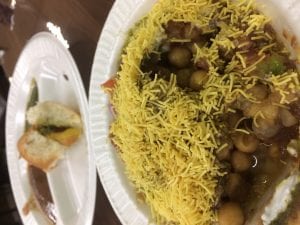Patrick Cinelli
On the drive to the India Bazaar, I was not sure what to expect our of the Bazaar. The word Bazaar reminded me of open markets with lots of open baskets of spices and other foreign candies like I saw at the Bazaar in Turkey when my family and I visited the country a few summers ago. What I saw instead was an ordinary grocery store. Obviously there was a large difference in the variety of food offered there and there were many vegetables and other foods that I had never seen before, but in terms of look and function, the Indian Bazaar could have been the same as any other grocery store. It could have been like any other grocery store on the outside, but as Sen says, “[ethnic culinary spaces in urban America] are sites of hybridity and cultural contact where multiple worlds, networks, processes, and agents interact with each other” (Sen 196). On the inside is not only the selling of food from a foreign country, but through the food, there is a mutual understanding of different cultures. Those cultures come together, and through the commonality of food, are able to learn about each other. Grocery stores are not what they seem on the outside, but hubs of cultural mixing.
The second thing I noticed about the grocery store was the small restaurant, or chaat café. The café had many different foods displayed that all looked foreign to me. The menu was not helpful either as it listed the many options of different Indian dishes in a language that I could not decipher. After a pause and a burst of inspiration, I went up to the counter and ordered two dishes, a chaat and a puri, which kind I am not sure. Trying new and different foods is one of my passions, so my anticipation while I waited for the food was immense. Once the two dishes came, I was not disappointed. The difference between my usual diet was stark. For one thing, there was not an ounce of meat on the plate, all the food at the café is vegetarian. Then there was the temperature of the food. While some of the food I eat is sold, usually I have a warm dish as my main course, but both dishes were served cold. While at an American restaurant I would have sent the food back, I was delighted to find that the temperature almost enhanced the flavor of the dish. I was more than satisfied with both of my dishes, but there was one problem. I have heard legends of the spiciness of Indian cuisine, but I had never had the chance to truly feel the burn and I truly wanted to experience it. Unfortunately that didn’t happen because they saw a bunch of green college kids and didn’t want to ruin the food for them. I was able to use the chili powder, which was labeled “salt,” to spice up the dish, which left a nice burning sensation in my mouth. The chaat, a mixture of “fried bits of chickpeas, puffed rice, browned mashed potato patties, fresh ginger, mung bean sprouts, spice-dusted toasted lentils, and topped with a tangy powder,” satisfied my appetite and my hunger to try new foods (Sen 204). I can’t wait to go back and try the rest of the delicacies on the menu.
Works Cited
Sen, Arijit. “From Curry Mahals to Chaat Cafes: Spatialities of the South
Asia Culinary Landscape.” California Studies in Food and Culture, Volume 3 4:
Curried Cultures:Globalization, Food, and South Asia. Ed. Krishnendu Ray and Tulasi
Srinivas. Berkeley: University of California, 2012. 196-218. Print.


